A) only I
B) only II
C) only III
D) only II and III
Correct Answer

verified
Correct Answer
verified
Multiple Choice
Use the following figure to answer the question.
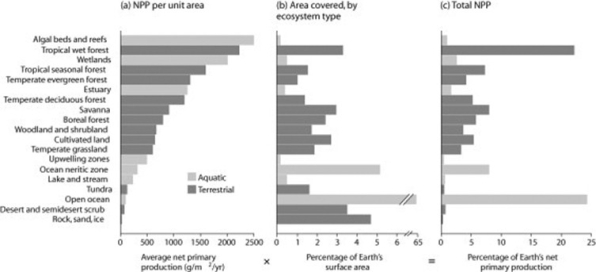 Considering its total area covered, which ecosystem type represented in the figure has a very low level of economic impact on Earth's ecosystem?
Considering its total area covered, which ecosystem type represented in the figure has a very low level of economic impact on Earth's ecosystem?
A) tropical wet forest
B) rock, sand, and ice
C) tropical seasonal forest
D) ocean neritic zone
Correct Answer

verified
Correct Answer
verified
Multiple Choice
What advantage would there be for an ecosystem ecologist to measure net ecosystem production (NEP) instead of net primary production (NPP) ?
A) NPP cannot be expressed in energy/unit of area/unit of time.
B) NEP can be expressed in terms of carbon fixed by photosynthesis for an entire ecosystem, minus respiration by producers, allowing the measurement of net CO₂ flux.
C) NEP represents the amount of energy from light converted to chemical energy, minus the energy used by all organisms for cellular respiration, which could indicate whether or not carbon is being stored.
D) NPP shows the rate at which the standing crop is utilized by consumers.
Correct Answer

verified
Correct Answer
verified
Multiple Choice
Use the following figure to answer the question.
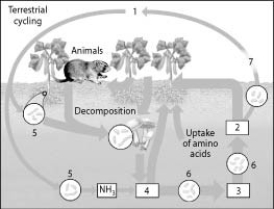 On the diagram of the nitrogen cycle, which number represents nitrite (NO₂) ?
On the diagram of the nitrogen cycle, which number represents nitrite (NO₂) ?
A) 1
B) 2
C) 3
D) 4
Correct Answer

verified
Correct Answer
verified
Multiple Choice
Use the following figure to answer the question.
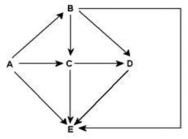 Food web for a particular terrestrial ecosystem (arrows represent energy flow and letters represent species)
Examine this food web for a particular terrestrial ecosystem. Species C is toxic to predators. Which species is most likely to benefit from being a mimic of C?
Food web for a particular terrestrial ecosystem (arrows represent energy flow and letters represent species)
Examine this food web for a particular terrestrial ecosystem. Species C is toxic to predators. Which species is most likely to benefit from being a mimic of C?
A) A
B) B
C) C
D) E
Correct Answer

verified
Correct Answer
verified
Multiple Choice
Use the following figure to answer the question.
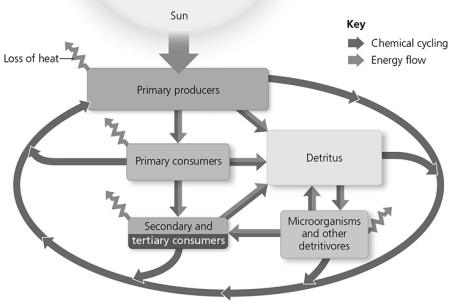 In the figure, what could the jagged arrow leaving microorganisms and other detritivores represent?
In the figure, what could the jagged arrow leaving microorganisms and other detritivores represent?
A) organic compounds broken down by bacteria
B) energy consumed by bacteria
C) energy lost from a worm during cellular respiration
D) CO₂ and heat loss from decomposing materials due to the effects of solar radiation and precipitation
Correct Answer

verified
Correct Answer
verified
Multiple Choice
Use the following figure to answer the question.
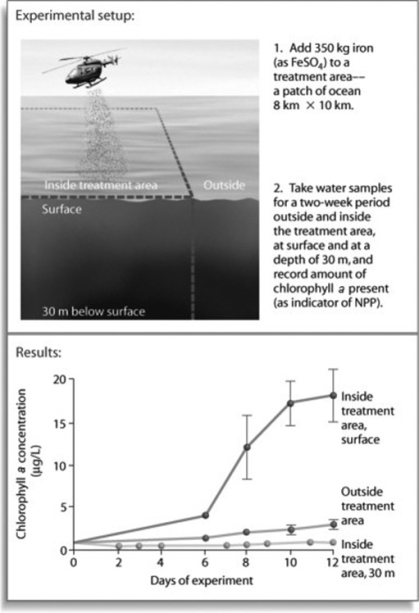 After looking at the experiment in the figure, what can be concluded about productivity in marine ecosystems?
After looking at the experiment in the figure, what can be concluded about productivity in marine ecosystems?
A) Nothing can be said based on this information.
B) Marine organisms break down iron for energy and thus for productivity.
C) Iron can be a limiting nutrient in productivity.
D) Productivity increases when chlorophyll a is added.
Correct Answer

verified
Correct Answer
verified
Multiple Choice
Use the following figure to answer the question.
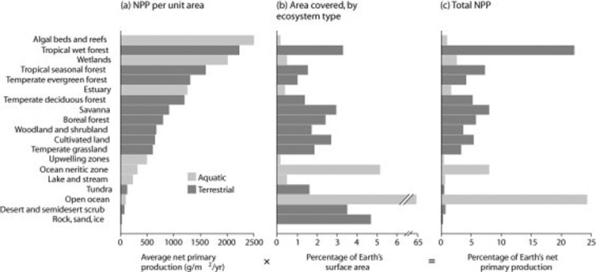 Which habitat types in the figure cover the largest area?
Which habitat types in the figure cover the largest area?
A) tropical wet forest
B) rock, sand, ice
C) algal beds and reefs
D) wetlands plus the ocean neritic zone
Correct Answer

verified
Correct Answer
verified
Multiple Choice
If the flow of energy in an arctic ecosystem goes through a simple food chain, perhaps involving humans, starting from phytoplankton to zooplankton to fish to seals to polar bears, then which of the following could be accurate?
A) Polar bears can provide more food for humans than seals can.
B) The total biomass of the fish is lower than that of the seals.
C) Seal populations are larger than fish populations.
D) Fish can potentially provide more food for humans than seal meat.
Correct Answer

verified
Correct Answer
verified
Multiple Choice
Which of the following statements is correct about biogeochemical cycling?
A) Phosphorus is the limiting nutrient that most widely affects biomass production.
B) The phosphorus cycle involves the weathering of rocks.
C) The carbon cycle has maintained a constant atmospheric concentration of carbon dioxide for the past million years.
D) The nitrogen cycle involves movement of diatomic nitrogen between the biotic and abiotic components of the ecosystem.
Correct Answer

verified
Correct Answer
verified
Multiple Choice
The goal of restoration ecology is to ________.
A) replace a ruined ecosystem with a more suitable ecosystem for that area
B) return degraded ecosystems to a more natural state
C) manage competition among species in human-altered ecosystems
D) prevent further degradation by protecting an area with park status
Correct Answer

verified
Correct Answer
verified
Multiple Choice
How is net ecosystem production (NEP) typically estimated in ecosystems?
A) by detecting the amount of heat energy released by the ecosystem
B) by measuring gas exchange from vegetation as well as estimates of respiration by all other organisms
C) by measuring the rate of decomposition by detritivores
D) by calculating the annual total of incoming solar radiation per unit of area
Correct Answer

verified
Correct Answer
verified
Multiple Choice
Which of the following organisms is incorrectly paired with its trophic level?
A) cyanobacterium-primary producer
B) grasshopper-primary consumer
C) zooplankton-primary producer
D) fungus-detritivore
Correct Answer

verified
Correct Answer
verified
Multiple Choice
Use the following figure to answer the question.
 Diagram of a food web (arrows represent energy flow and letters represent species)
If the figure represents a marine food web, zooplankton are most likely ________.
Diagram of a food web (arrows represent energy flow and letters represent species)
If the figure represents a marine food web, zooplankton are most likely ________.
A) A
B) B
C) C
D) E
Correct Answer

verified
Correct Answer
verified
Multiple Choice
Use the following figure to answer the question.
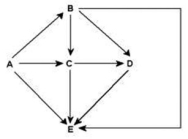 Food web for a particular terrestrial ecosystem (arrows represent energy flow and letters represent species)
Examine this food web for a particular terrestrial ecosystem. Which species is most likely a decomposer on this food web?
Food web for a particular terrestrial ecosystem (arrows represent energy flow and letters represent species)
Examine this food web for a particular terrestrial ecosystem. Which species is most likely a decomposer on this food web?
A) A
B) B
C) C
D) E
Correct Answer

verified
Correct Answer
verified
Multiple Choice
Use the following figure to answer the question.
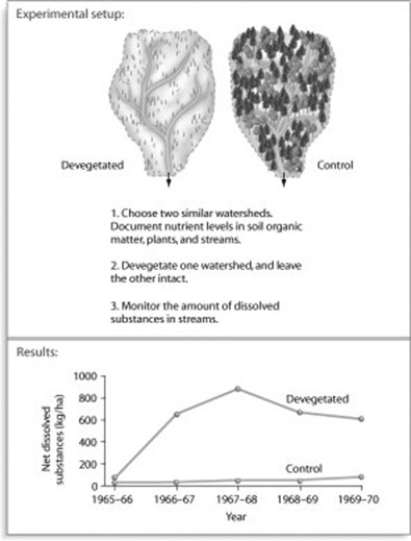 Based on the figure, which of the following are plausible reasons for the results?
I.Nutrients in the control watershed are being lost due to evapotranspiration from leaves.
II.Nutrients dissolve in the water running through the watershed.
III.Nutrients are attached to small particles of sand or clay that leave the watershed.
IV.Intact vegetation includes plant roots that held soil particles and prevented nutrient loss.
Based on the figure, which of the following are plausible reasons for the results?
I.Nutrients in the control watershed are being lost due to evapotranspiration from leaves.
II.Nutrients dissolve in the water running through the watershed.
III.Nutrients are attached to small particles of sand or clay that leave the watershed.
IV.Intact vegetation includes plant roots that held soil particles and prevented nutrient loss.
A) only I and III
B) only II and IV
C) I, II, III, and IV
D) only II, III, and IV
Correct Answer

verified
Correct Answer
verified
Multiple Choice
Consider the food chain of grass → grasshopper → mouse → snake → hawk. About how much of the chemical energy fixed by photosynthesis of the grass (100 percent) is available to the hawk?
A) 0.01%
B) 0.1%
C) 1%
D) 10%
Correct Answer

verified
Correct Answer
verified
Multiple Choice
Which of the following would be considered an example of bioremediation?
A) adding nitrogen-fixing microorganisms to a degraded ecosystem to increase nitrogen availability
B) using a bulldozer to regrade a strip mine
C) dredging a river bottom to remove contaminated sediments
D) adding fertilizer to soil poor in nutrients to increase plant growth
Correct Answer

verified
Correct Answer
verified
Multiple Choice
Use the following figure to answer the question.
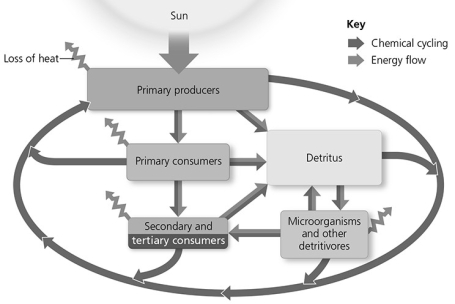 In the ecosystem figure, which unit of the food web has the potential to lose the most energy as heat?
In the ecosystem figure, which unit of the food web has the potential to lose the most energy as heat?
A) secondary and tertiary consumers
B) primary consumers
C) primary producers
D) microorganisms and other detritivores
Correct Answer

verified
Correct Answer
verified
Multiple Choice
Use the following figure to answer the question.
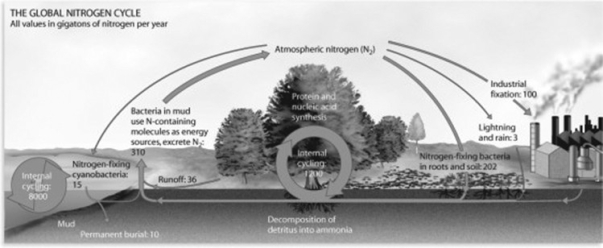 Consider the global nitrogen cycle depicted in the figure. How are humans altering this cycle?
Consider the global nitrogen cycle depicted in the figure. How are humans altering this cycle?
A) industrial nitrogen fixation
B) nitrogen lost to the atmosphere
C) reduction of nitrogen available to terrestrial ecosystems
D) reduction of nitrogen fixation by bacteria
Correct Answer

verified
Correct Answer
verified
Showing 21 - 40 of 68
Related Exams